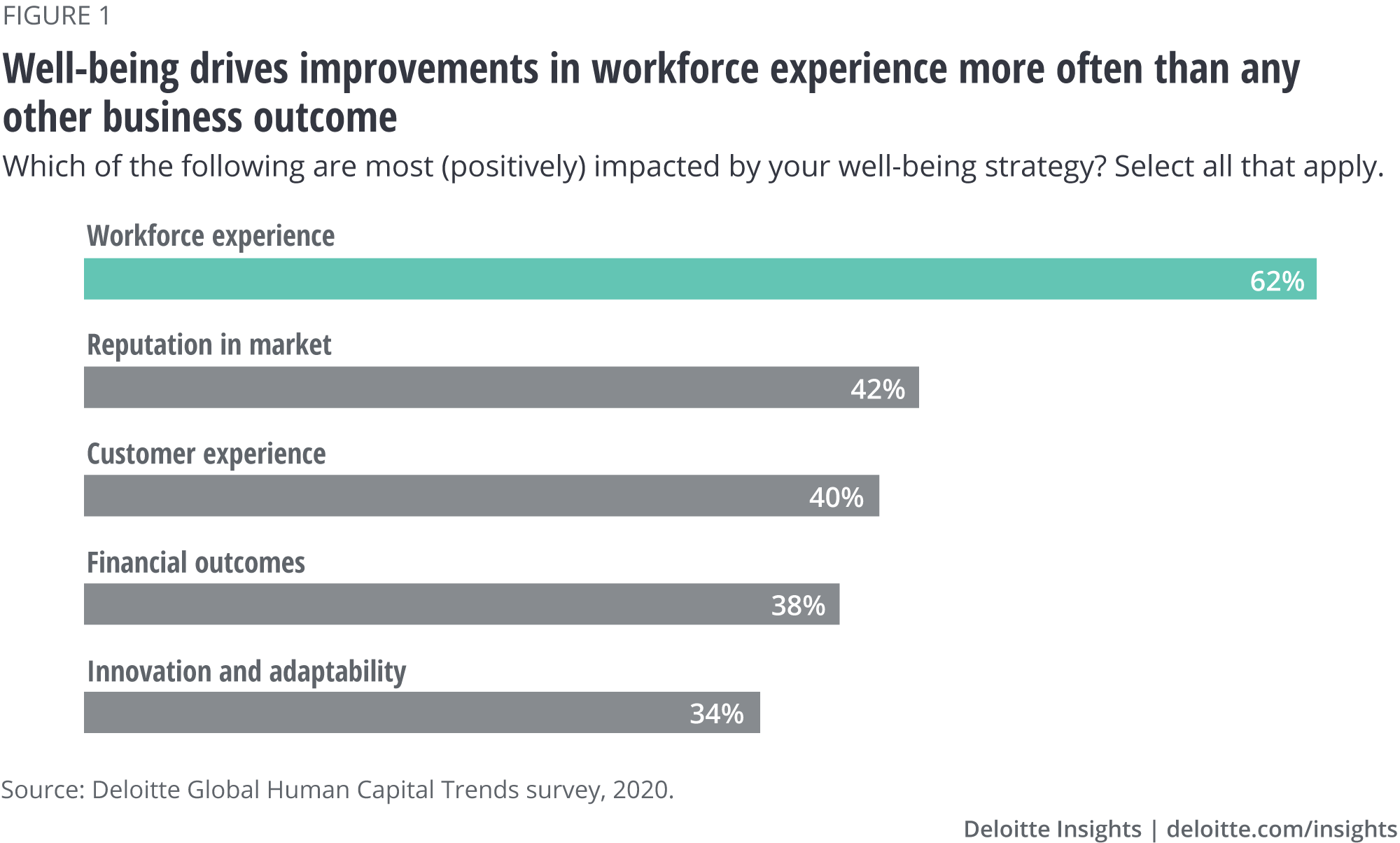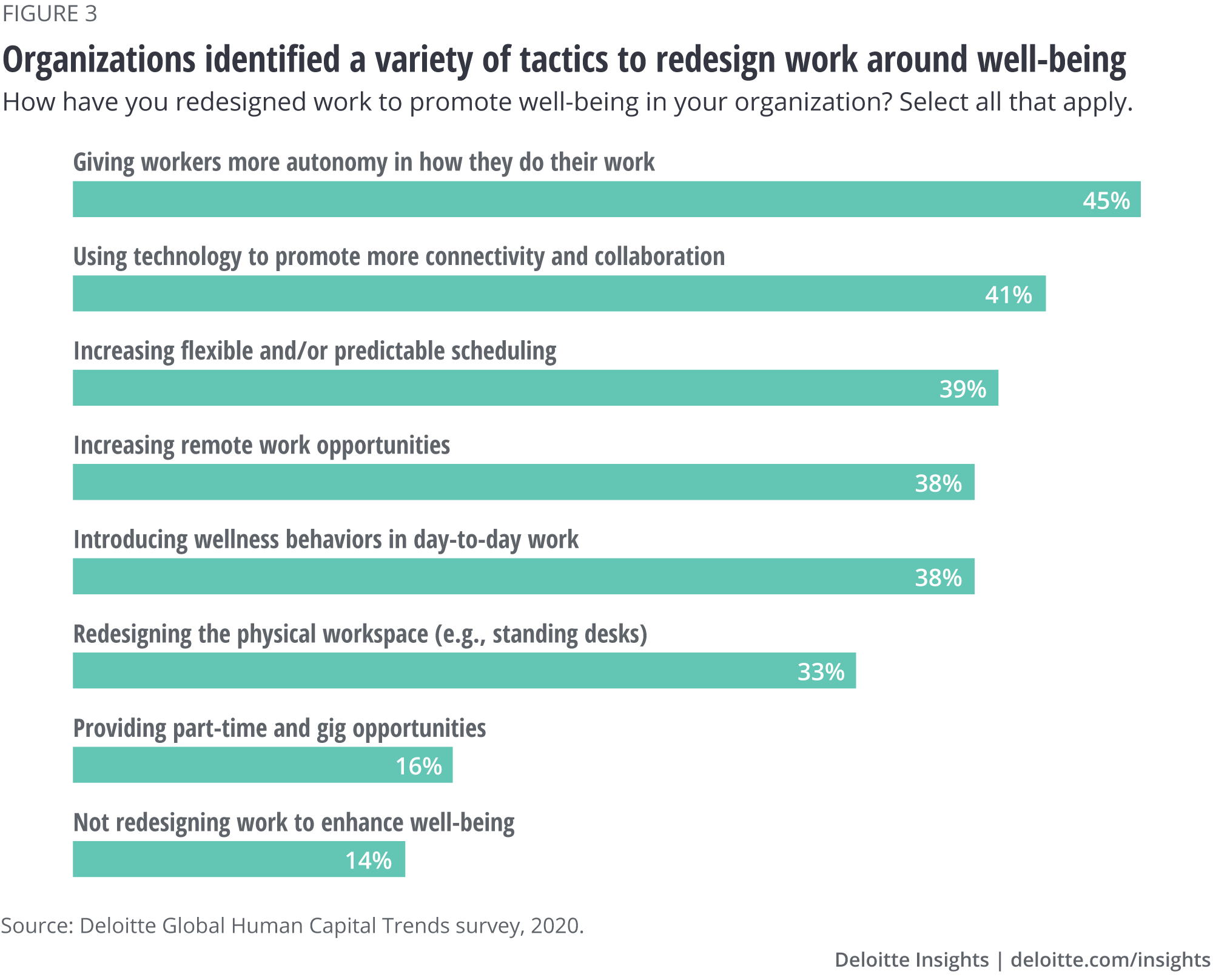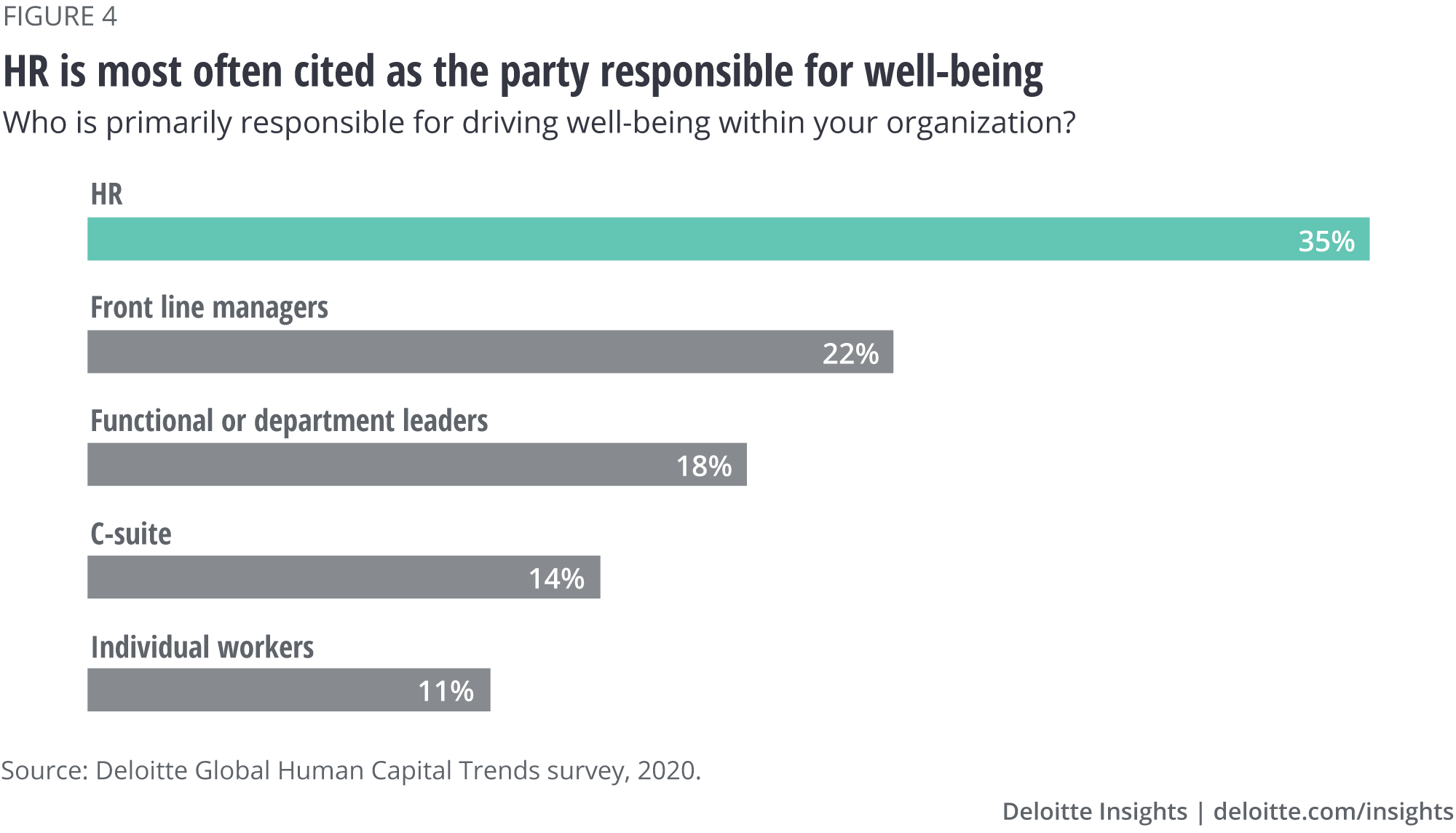
Designing work for well-being Living and performing at your best
9
15 May 2020
Integrating well-being into the design of work itself can strengthen the link between worker well-being and organizational performance, supporting well-being not just for individuals but for teams and for the organization at large.
2021 Global Human Capital Trends
Sign up to receive a copy of our new approach to Trends launching this winter
Worker well-being is a top priority today, largely because of the widespread belief that it supports organizational performance. Yet many organizations are missing the biggest opportunity for well-being to drive performance: integrating well-being into the design of work itself. Building well-being into work takes an organization’s focus beyond interventions to support individual well-being to address well-being for the broader team and for the organization at large. By doing so, organizations can restructure work in ways that help workers not only feel their best but perform at their best, strengthening the tie between well-being and organizational outcomes and fostering a greater sense of belonging overall.
The Readiness Gap: Well-being had the largest gap between importance and readiness across this year’s trends, with 80 percent of organizations saying worker well-being is important or very important for their success over the next 12–18 months, but only 12 percent saying they are very ready to address this issue.
Learn more
Explore the Human Capital Trends collection
Read more about Integrating tech and well-being
Watch the video
Learn about Deloitte's services
Order a copy of Work Disrupted, Deloitte's new book on the accelerated future of work
Explore 5 lessons from the pandemic for the future of work
Go straight to smart. Get the Deloitte Insights app
Create a custom PDF
Eighty percent of respondents to this year’s Global Human Capital Trends survey identified well-being as an important or very important priority for their organization’s success, making it the year’s top-ranked trend for importance. And it’s clear that organizations around the world have taken notice. Large employers in the United States spent an average of US$3.6 million on well-being programs in 2019, at a cost of US$762 per employee.1 The global corporate well-being market has grown at an accelerated 7 percent CAGR, and is likely to continue growing, rising from US$53.6 billion in 2018 and expected to reach US$90.7 billion by 2026.2
The investments made in the well-being space are for good reason. Ninety-five percent of HR leaders agree that burnout impacts employee retention,3 and a Limeade and Quantum Workplace study found that employees with higher well-being are more likely to feel engaged at work, enjoy their work, and recommend their organization.4 In our own survey this year, 94 percent of respondents agreed that well-being drives organizational performance to some extent.
However, a closer look at our survey findings reveals that the return on investment (ROI) in worker well-being may not be as strong as it could be. Sixty-one percent of our survey respondents said that their organizations are not measuring the impact of well-being on organizational performance at all, and those respondents whose organizations did measure well-being’s impact on performance were most likely to report that that impact lay largely in improving the workforce experience (figure 1). Fewer than half believed that their well-being strategy was positively affecting other business outcomes, such as the organization’s customer experience, financial outcomes, reputation, and innovation and adaptability.

Why this gap in ROI? Let’s start with the fact that addressing well-being effectively isn’t a simple undertaking. While modern well-being strategies have historic roots in the occupational health programs established in the 19th century designed to make work safe, they have since evolved to encompass a wide set of programs around workers’ physical, financial, and even emotional health. The good news is that our survey respondents have recognized this shift, with the majority of respondents indicating that their well-being strategies focus, at a minimum, on the physical, mental, and financial health of their employees (figure 2).

But the impact of modern careers and the rise of phenomena such as workplace stress have raised the question of whether employers should be doing even more. A study of workers in the United States and the United Kingdom found that 94 percent report feeling stress at work, with one-third saying their stress level is high to unsustainably high.5 Fifty-four percent of workers report that their home life is negatively affected by work at least once a week, and more than 50 percent report sleep loss.6 This workplace stress brings physical health consequences as well, leading the World Health Organization to classify burnout “resulting from chronic workplace stress that has not been successfully managed” as a diagnosable health condition.7
Given the level of the investments that are already being made, and the fact that 96 percent of our respondents agreed that well-being was an organizational responsibility, it’s clear that this is an area that needs some additional focus and attention. The question is: Where should organizations go from here?
Well-being through the years in Global Human Capital Trends
What started the decade as a concern about worker overload has evolved into a complex discussion about the role of organizations not only in driving well-being, but in optimizing business performance by integrating well-being into the design of work. In 2014, our chapter on “The overwhelmed employee” explored ways to improve employee satisfaction, teamwork, and productivity by simplifying work in an always-on world. By 2018, we had seen an explosion in the digital well-being market, with more than US$2 billion in venture capital invested between 2016 and 2018.8 Our chapter on “Well-being: A strategy and a responsibility” examined the expansion of well-being into a diverse set of programs designed to protect employees’ health, social well-being, and emotional well-being, speaking to the growing recognition of well-being as a driver of organizational performance. That same year, “The hyper-connected workplace” began exploring the intimate link between work and well-being, including management’s decision to potentially not use certain digital tools based on their anticipated impact on culture and pace of communication within the organization. This year, we discuss how building well-being into work can not only yield increased benefits in productivity and organizational performance, but also drive the creation of meaningful work (a call to action in last year’s “From employee experience to human experience” chapter) and strengthen the relationship between the individual and the organization.
Our 2020 perspective
Unlike in prior years of Global Human Capital Trends, this year, we had two trends that rose to the top with almost identical importance scores: well-being and belonging. We believe that both of these topics rose to the top because they pointed to a real challenge that many organizations are grappling with in the age of the social enterprise: How can they take something so personal and translate it into something that can have a broader impact beyond the individual?
In our chapter on belonging, we reported that our survey found that organizations need to foster belonging on three levels: comfort, where workers feel respected and treated fairly; connection, where workers have strong relationships with colleagues and teams; and contribution, where workers can see and appreciate the impact they are having on the organization’s goals at large. We believe there is an opportunity to look at well-being through a similar lens. While comfort has been enabled with a focus on occupational health and safety, and a connection to the workplace has been made by bringing a focus on life to work, contribution remains unresolved overall. That is because well-being programs often focus on the individual at work, rather than the individual in work. To be able to create a sense of contribution that translates into true organizational performance, organizations need to expand their focus from programs adjacent to work to designing well-being into the work itself.
Redesigning work around well-being can yield impressive results. Microsoft Japan is an early example of an organization that experimented with this, reducing its work week from five days to four—with results that challenge the common perception that well-being and productivity are at odds. In addition to shortening the work week, Microsoft Japan changed certain aspects of the way its people worked: Employees were asked to use a digital chat tool rather than email and to limit meetings to just 30 minutes and five people.9
The changes that Microsoft Japan put into place are only one of the many ways in which organizations can design work for well-being. Our research shows that a focus on well-being can be achieved by making thoughtful adjustments to how, when, where, and by whom the work is done. It could mean structuring work so that performance does not depend on any single individual, making it possible for all workers and leaders to take meaningful leaves of absence. It can mean giving workers more control over when and where they work so that they can work at the times and places that they feel most productive. And it could mean giving workers access to additional human or material resources in situations where stressors, whether physical or mental, could compromise individual or team performance.
Our survey results revealed a number of different tactics that organizations use today to bring well-being more to the forefront (figure 3). But despite the options available, relatively few organizations have recognized or acted upon them as part of an integrated strategy. Seventy-nine percent of this year’s respondents report that their organization’s strategy does not explicitly seek to integrate well-being into the design of work—representing a huge missed opportunity.

To start the process of integrating well-being into the design of work, we believe there are three critical steps to consider. First, organizations should establish the right level of ownership for well-being—ownership by the group that has the greatest ability to influence the design of work. Second, organizations should spend the time to understand their workforce’s well-being needs—starting with the organizational and HR data that is now at their fingertips. And third, organizations should put processes in place to engage employees in work design deliberations—recognizing that the more that individuals are involved in the design process, the greater the chance that the changes made will have a positive, long-lasting impact.
With regard to ownership for well-being, our survey responses revealed a mixed bag (figure 4). While HR was the most often-cited owner, organizations also reported ownership of well-being by frontline managers, functional or department leaders, and, in some cases, even the C-suite. While there will never be a one-size-fits-all approach to ownership, our survey results show that ownership of well-being by HR is a solid strategy: When we looked at organizations that were more and less mature with respect to well-being, we found that the organizations with the most mature well-being strategies were those where HR was the primary owner.10 Regardless of who owns well-being, it’s critical that they have the ability to influence the design of work as well. As indicated in our closing chapter—“A memo to HR”—we believe that the ownership of work is a huge opportunity for HR to expand their impact and shift from a focus on cultivating the talent of today to imagining the work of tomorrow.

With all of the HR, employee, and organizational data available today, there is a great opportunity to gain insights into workers’ needs related to well-being and to build those needs into the design of work. A global footwear and apparel company did just that when it analyzed its global employee engagement survey results and recognized a growing need for workers to have more and better access to rest and recovery. In response, the company increased workers’ autonomy over work by introducing a new flexible time-off program. The program, which gave employees more jurisdiction over their work schedules, had a positive effect on corporate culture and improved collaboration and teaming across the organization.11
Other organizations are developing new tools to collect workforce well-being data. Researchers at the Mayo Clinic developed a Well-Being Index that measures multiple dimensions of well-being among doctors, nurses, medical students, and other health care workers.12 The tool, which assesses dimensions of distress and well-being such as likelihood of burnout, meaning in work, and work-life integration, has been used with more than 120,000 providers, allowing organizations to improve the workplace based on “data, not guesses.”13
Finally, worker input is critical to understand what changes to work practices may have the greatest impact on well-being. In Germany, labor unions have started to promote “health circles”—systematic, structured workshops where workers discuss ways to minimize or eliminate health risks and other stress factors in their day-to-day work. These health circles are already being used in German governmental administration units, manufacturing organizations, and public institutions, empowering employees to redesign their own work to maximize both well-being and performance.14 In one German hospital system, workers’ feedback guided key work changes to mitigate common sources of stress, including better scheduling, new systems for clearer communication, empowering employees to make decisions, and changes to avoid overloading short-staffed teams. A study found that these efforts improved both work quality and worker health.15
Learning by example
One example of an organization that has integrated well-being into the design of work is the early childhood education company Learning Care Group. Learning Care Group recognized a need to support teachers’ well-being as they handle stressful situations in the classroom—especially given that 95 percent of the behaviors that teachers consider to be challenging are developmentally appropriate.16 To do this, Learning Care Group implemented a series of changes—including changing the physical design of classrooms to enhance teacher-child interactions, updating the curriculum with new content, and offering new or refreshed resources to teachers—to create a more positive work environment. Learning Care Group even introduced new technologies into the classroom, including an app, myPath, that provides on-demand resources and strategies when teachers encounter challenging student behaviors such as hitting and biting. Not only have these changes built resilience among its teachers to handle high-stress situations, but Learning Care Group has also seen lower disenrollment of children and higher teacher retention since making these changes.17
Pivoting ahead
Given the immense pressure on organizations to promote worker well-being, it’s no surprise that organizations have grasped at a large number of levers to do so. But to date, almost all of these efforts have focused on the health and well-being of individuals, rather than the well-being of the entire worker population through the redesign of work. Organizations that integrate well-being into work may find that it reduces the need for remediation of work’s negative effects, freeing up resources to invest in other areas and increasing individual and team contributions to organizational outcomes. In this way, building well-being into the work becomes an effort that can yield immediate benefits in productivity while paying ongoing dividends by driving meaningful work, greater worker resilience, and higher organizational performance, setting the stage for long-term success.
© 2021. See Terms of Use for more information.
Explore the collection
-
Superteams Article4 years ago
-
Knowledge management Article4 years ago
-
Beyond reskilling Article4 years ago
-
The compensation conundrum Article4 years ago
-
Governing workforce strategies Article4 years ago
-
A memo to HR Article4 years ago























